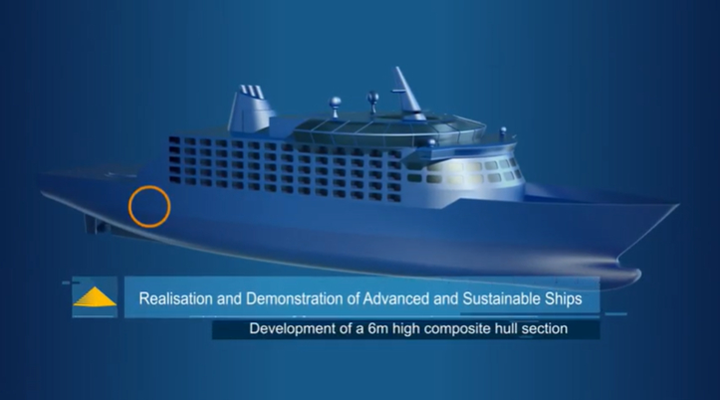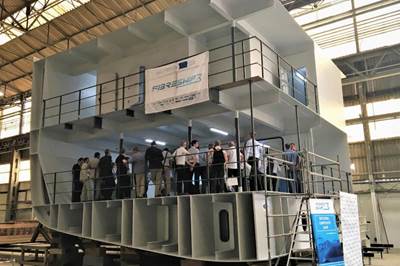Impact tests on RAMSSES ship hull demonstrator show resilience of composites
Damen Shipbuilding and project consortium partners test 6-meter-high, resin-infused composite hull section.

Photo Credit: Damen Schelde Naval Shipbuilding
Partners in the Realisation and Demonstration of Advanced Material Solutions for Sustainable and Efficient Ships (RAMSSES) project are working to demonstrate a composite ship that weighs 40% less than a steel equivalent, offering considerable reduction in fuel consumption and emissions.
Led by Damen Schelde Naval Shipbuilding (DSNS, Gorinche, Netherlands) and Damen Gorinchem (DSGo), in cooperation with InfraCore Co. (Rotterdam, Netherlands), Evonik (Essen, Germany), Airborne UK and TNO (the Netherlands Organisation for applied scientific research), a six-meter high, composite hull section was unveiled in July 2020, after three years of development. Titled, “Custom Made Hull for Offshore Vessel”, this is one of 13 demonstrators being constructed in the RAMSSES project.
Unique in this demonstrator project is that the whole cycle from product design, novel resin development, alternative fiber architectures, novel joining solutions, scaling up infusion technology, validation of large composite structures and risk-based design are being developed and tested under the auspices of the marine classification society Bureau Veritas (BV). In addition, the partners pioneered the capability to infuse thick laminates up to six meters in height that represent full-scale ship hull structures.
As described in CW’s Dec 2019 feature “Removing barriers to lightweighting ships with composites”, and in DSNS press releases, there is currently an absence of approved guidelines for composite vessels. Regulations covering composite shipbuilding only cover vessels up to 500 tonnes — approximately 25 meters in length. RAMSSES aims to address this by scaling up the composite technology and capacity to design, produce and market composite vessels up to 85 meters long in full compliance with Safety of Life at Sea (SOLAS) and class regulations.
It will do this by validating the production process of large composite structures with economic improvement and key performance indicators for fire resistance, impact resistance and structural robustness. Furthermore, performing the assembly at DSNS has demonstrated the feasibility to construct composite vessels in shipyards traditionally dedicated to steel.
Now, impact tests on the RAMSSES demonstrator at DSNS in Vlissingen, Netherlands, are proving the resilience of composites to harsh marine environments. Multiple impact tests surpassing helicopter emergency landing loads were demonstrated on the RAMSSES hull shell and its composite helicopter deck.
This work section of the RAMSSES project is led by DSNS and Damen Shipyards Gorinchem, which has developed the baseline design. Engineering has been performed by Airborne UK and InfraCore Co., who have brought the company’s expertise in composites to the project. Evonik has developed the resin to infuse the composites. Following assembly, TNO will perform full-scale tests for validation of design, quality management and structural performance. Bureau Veritas has provided consultancy and advice that will provide a smart track to approval.
The approval process has been developed in close cooperation with Research Institutes of Sweden (RISE), Netherlands Maritime Technology Foundation and Bureau Veritas. A Hazld (hazard identification) test has already been performed by RISE and Bureau Veritas to address all fire risks.
“The work we are doing here is important for the future of shipping. Sustainability is a major focus in industry right now and shipbuilding is no exception,” says Marcel Elenbaas, senior engineer at Research & Technology Support DSNS. “The use of composites for larger ships has significant consequences for the entire design of the ship. If it is lighter, a vessel uses less fuel and produces lower emissions. The vessel also requires smaller engines, which means more space for additional systems, making for a more versatile platform. And of course, composites require considerably less maintenance than a steel vessel. With RAMSSES we have the opportunity to demonstrate the effectiveness and viability of large-scale composite shipbuilding.”
The RAMSSES project has received funding from the European Union’s Horizon 2020 research and innovation program under grant agreement No 723246. Other demonstrators in the RAMSSES project include innovative components and modular lightweight systems, maritime equipment, the application of high-performance steels in load-carrying hull structures, the integration of composite materials in various structures for global repair.
Related Content
JEC World 2022, Part 3: Emphasizing emerging markets, thermoplastics and carbon fiber
CW editor-in-chief Jeff Sloan identifies companies exhibiting at JEC World 2022 that are advancing both materials and technologies for the growing AAM, hydrogen, automotive and sustainability markets.
Read MoreJEC World 2022, Part 1: Highlights in sustainable, digital, industrialized composites
JEC World 2022 offered numerous new developments in composites materials, processes and applications, according to CW senior editor, Ginger Gardiner, most targeting improved sustainability for wider applications.
Read MoreCarbon fiber in pressure vessels for hydrogen
The emerging H2 economy drives tank development for aircraft, ships and gas transport.
Read MoreAdvanced Fiberglass Industries: Composites enable innovation
With decades of composites design and fabrication experience, Dubai-based AFI turns problems into solutions.
Read MoreRead Next
Removing barriers to lightweighting ships with composites
EU consortia propel large demonstrators, new technology and affordable certification.
Read MoreFrom the CW Archives: The tale of the thermoplastic cryotank
In 2006, guest columnist Bob Hartunian related the story of his efforts two decades prior, while at McDonnell Douglas, to develop a thermoplastic composite crytank for hydrogen storage. He learned a lot of lessons.
Read MoreCW’s 2024 Top Shops survey offers new approach to benchmarking
Respondents that complete the survey by April 30, 2024, have the chance to be recognized as an honoree.
Read More


























